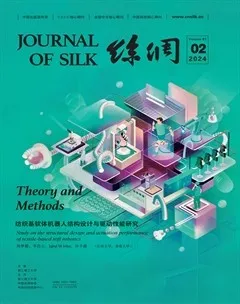電阻式柔性觸覺傳感器的研究與醫(yī)養(yǎng)健康領(lǐng)域應(yīng)用現(xiàn)狀
殷霞 張士進(jìn) 田明偉 劉紅
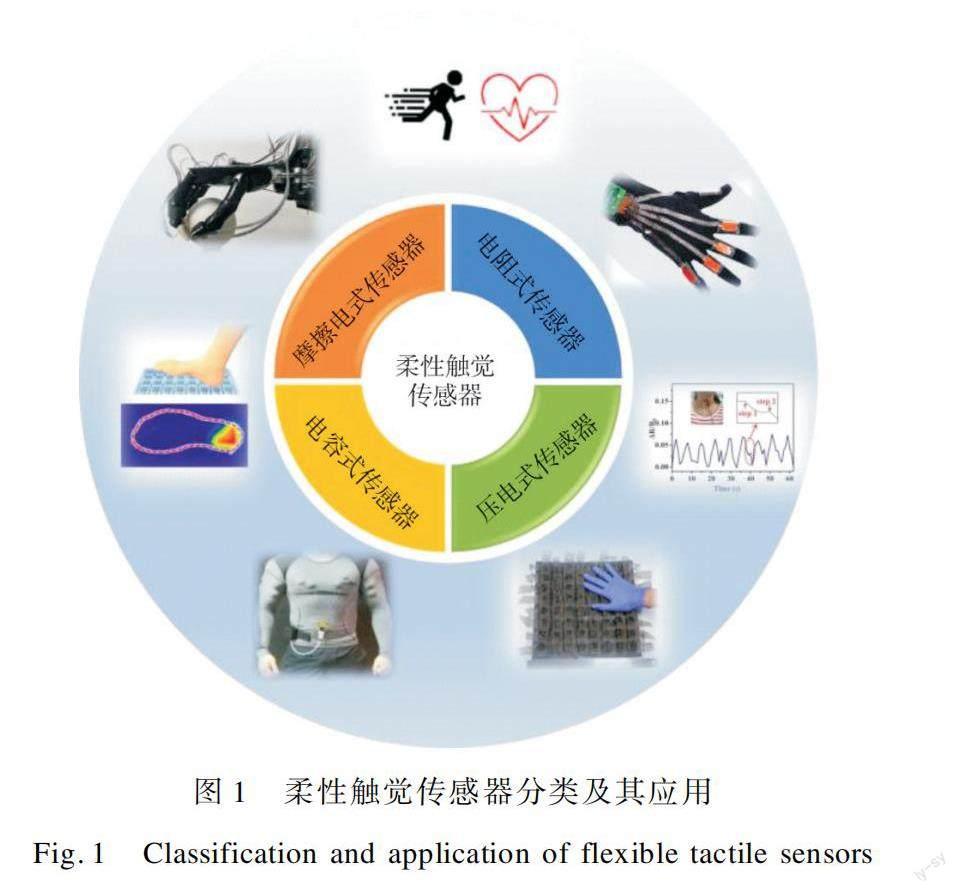
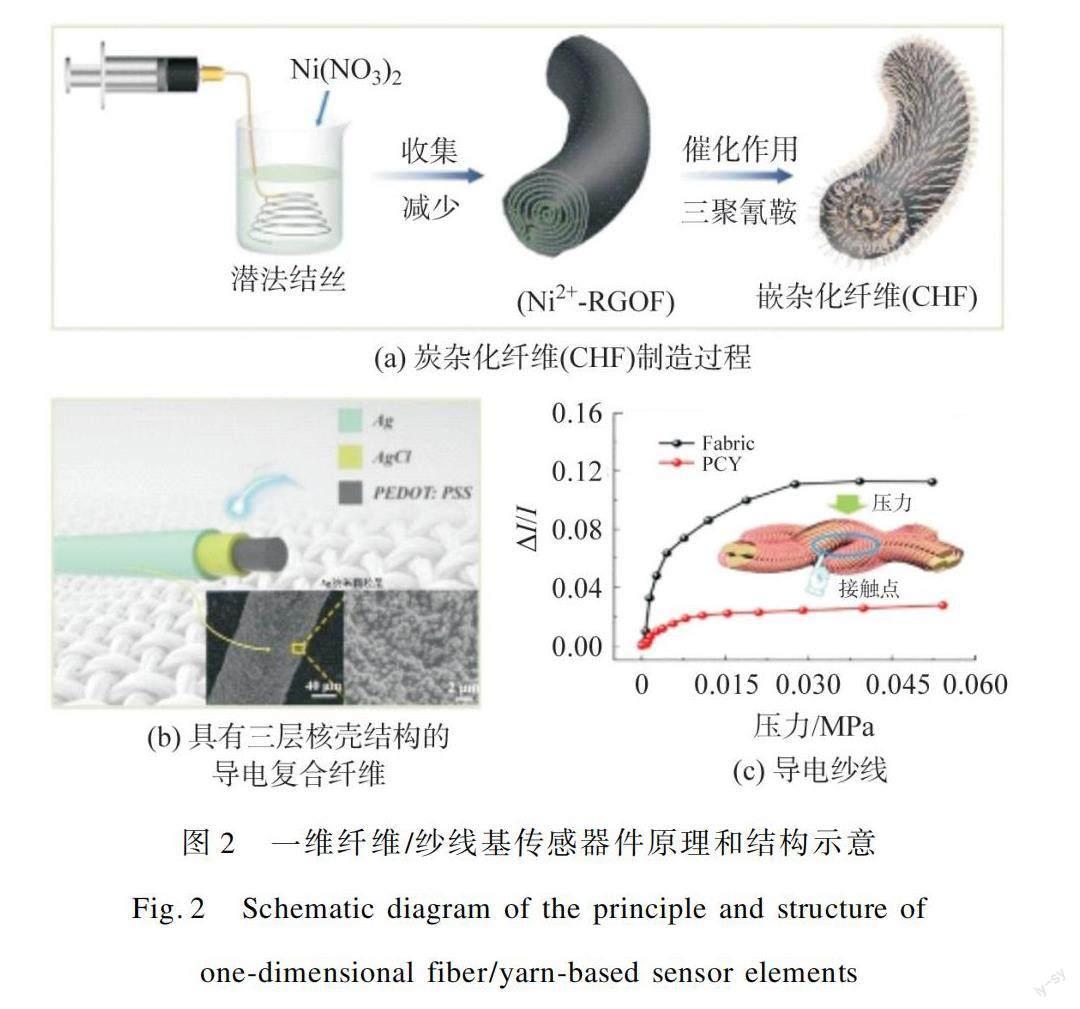
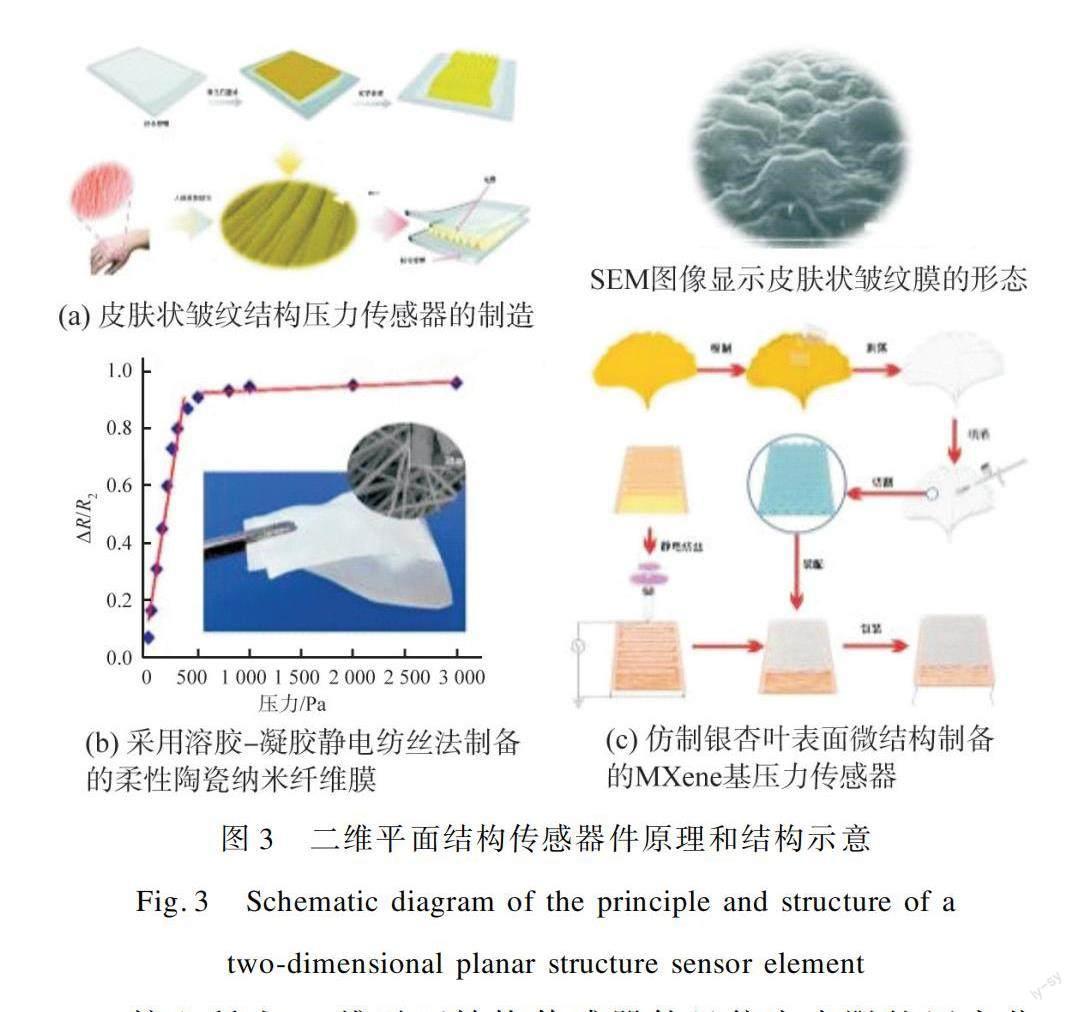
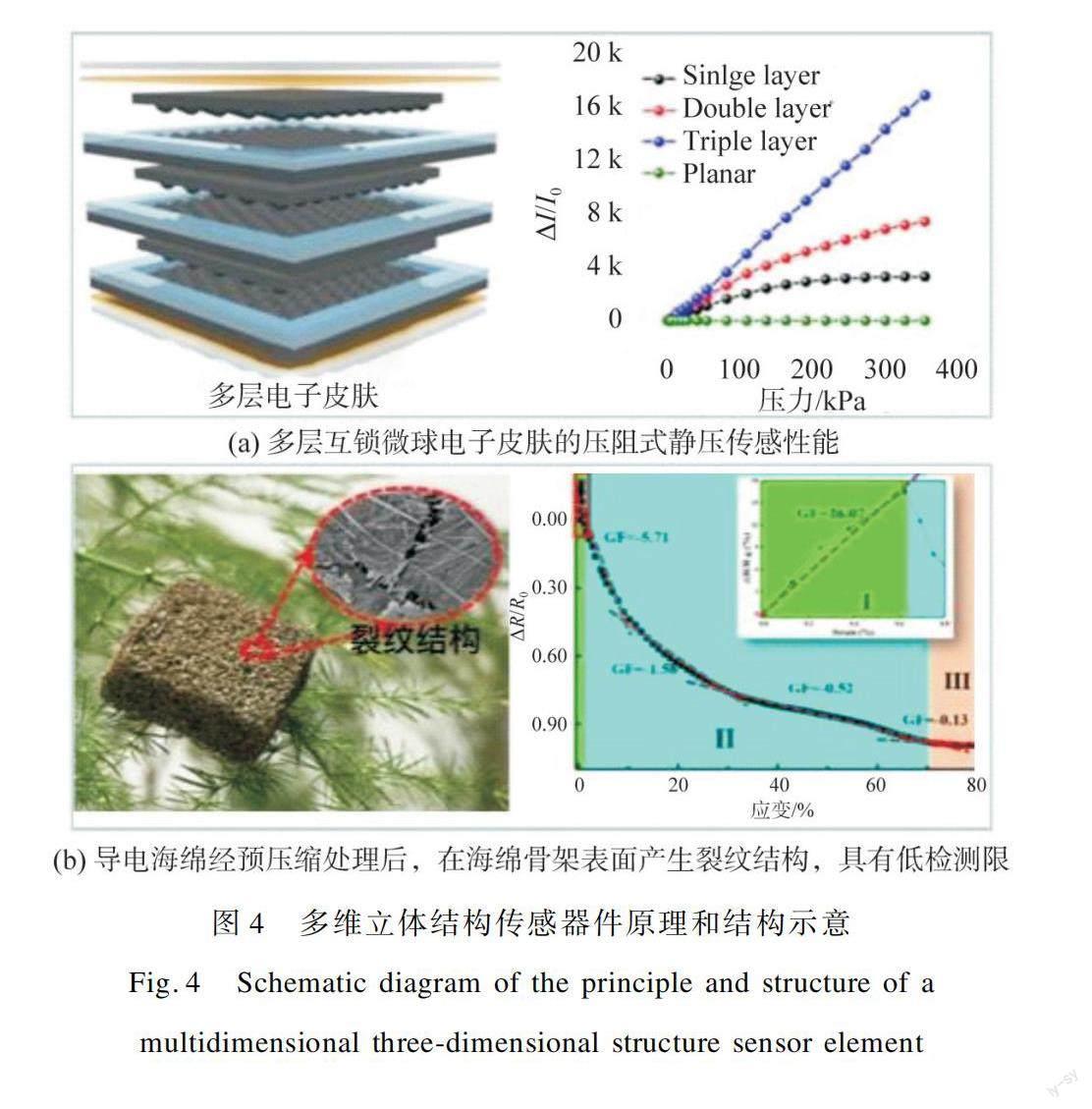
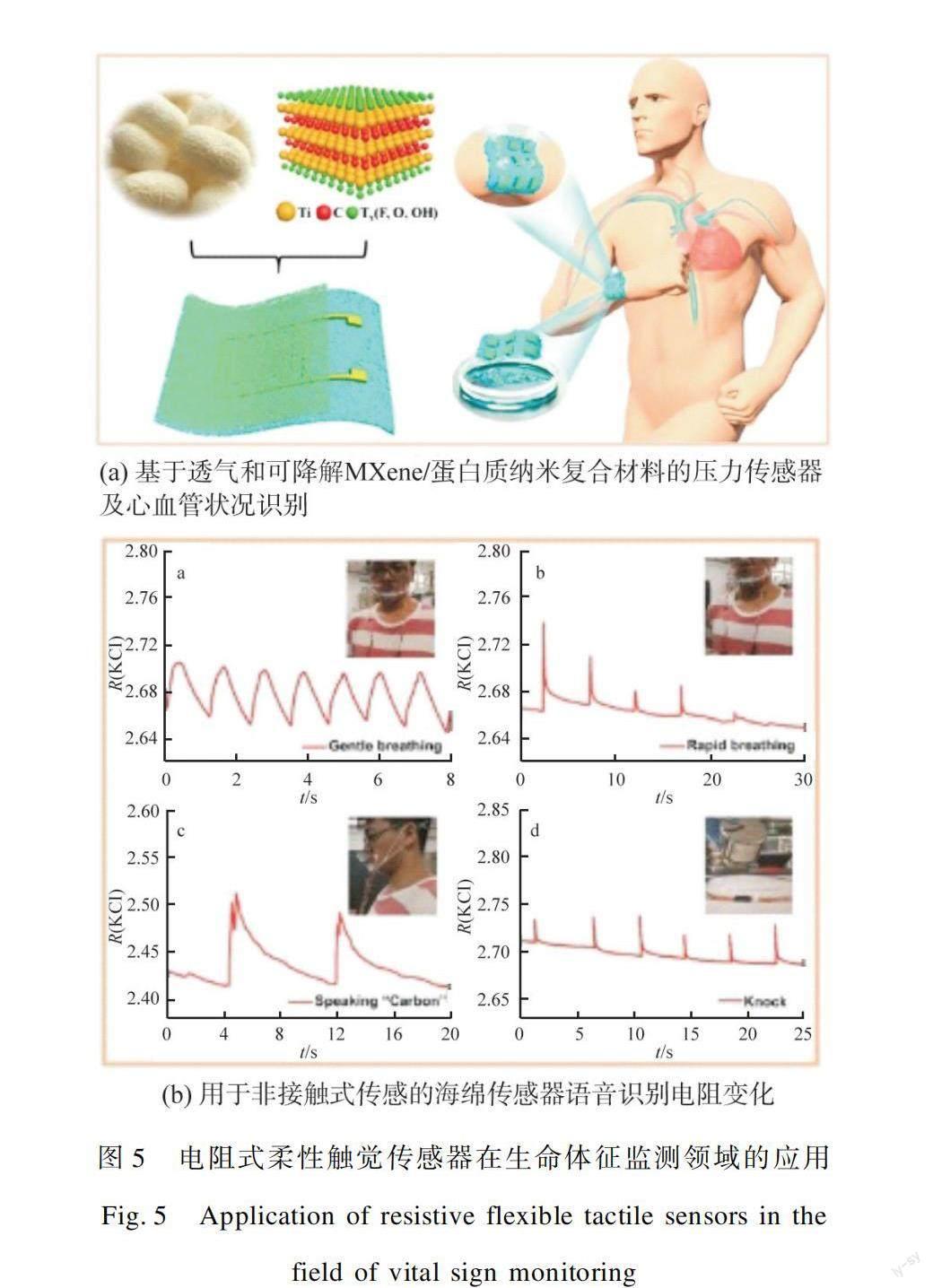
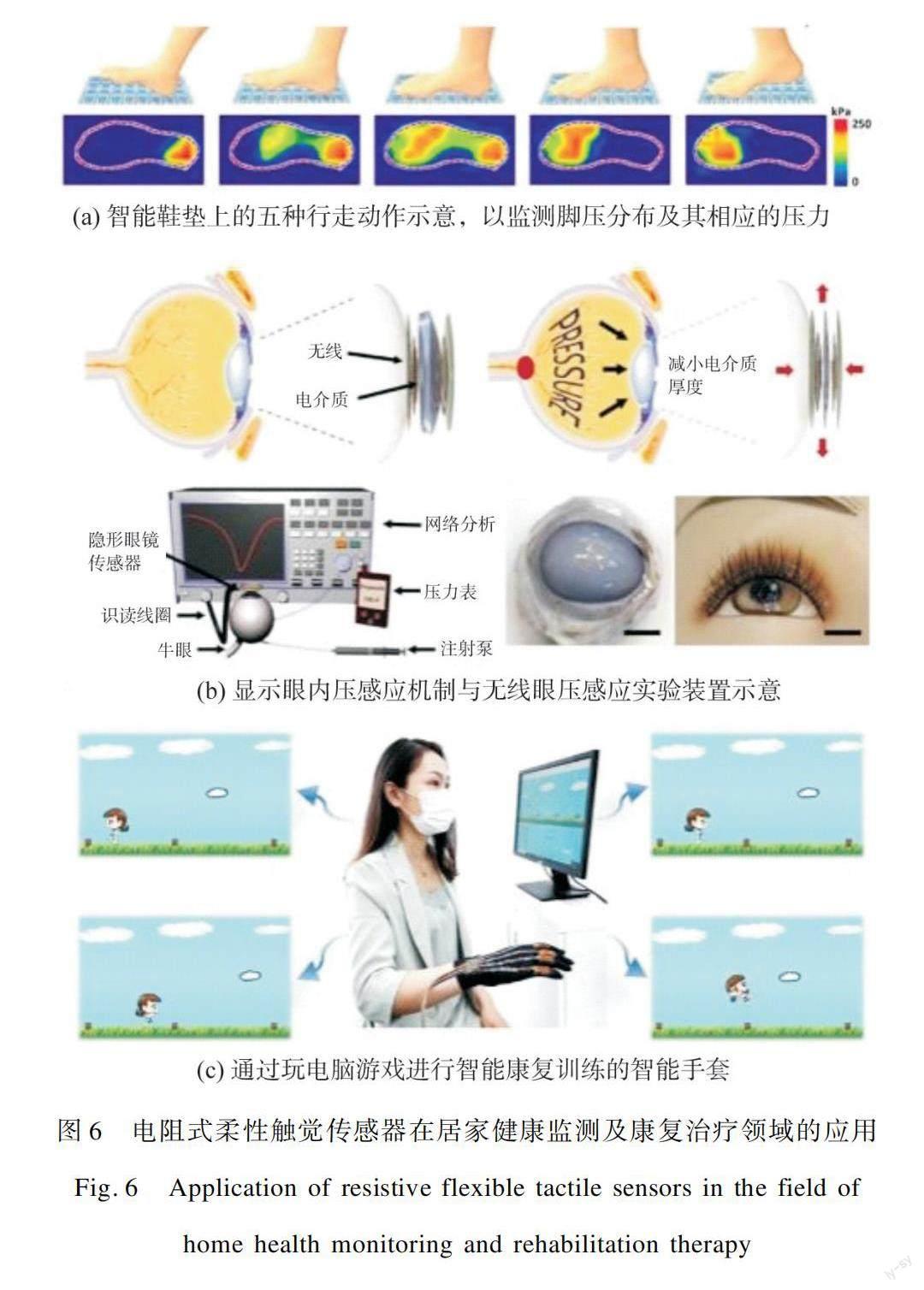
摘要:近年來,可穿戴智能系統(tǒng)的進(jìn)步對柔性壓力傳感器提出迫切的需求。其中,電阻式柔性觸覺傳感器因其原理簡單、易于加工、集成效率高等特點(diǎn)得到了迅速發(fā)展。但是,如何實(shí)現(xiàn)傳感器在寬壓力監(jiān)測范圍內(nèi),具有高靈敏度仍是研究者們要面臨的挑戰(zhàn)。為了解決上述問題,除了選擇先進(jìn)的功能材料和合適的襯底材料,優(yōu)化傳感器結(jié)構(gòu)也是一個(gè)重要的研究方向。本文立足于傳感器件的結(jié)構(gòu)設(shè)計(jì),分別介紹了一維的纖維/紗線傳感器件,基于表面微結(jié)構(gòu)、納米結(jié)構(gòu)構(gòu)筑的二維平面?zhèn)鞲衅骷熬哂锌臻g結(jié)構(gòu)和高空隙的多維立體結(jié)構(gòu)傳感器件,通過以上結(jié)構(gòu)設(shè)計(jì)實(shí)現(xiàn)了傳感器件性能的提升,最后分析了其在醫(yī)養(yǎng)健康領(lǐng)域的實(shí)際應(yīng)用進(jìn)展。
關(guān)鍵詞:電阻式柔性觸覺傳感器;結(jié)構(gòu)設(shè)計(jì);醫(yī)養(yǎng)健康;一維纖維/紗線傳感器件;二維平面結(jié)構(gòu)傳感器件;多維立體結(jié)構(gòu)傳感器件;健康監(jiān)測
中圖分類號:TP212.3; TQ342.8
文獻(xiàn)標(biāo)志碼:A
文章編號:10017003(2024)02007609
DOI:10.3969/j.issn.1001-7003.2024.02.009
收稿日期:20230914;
修回日期:20231220
作者簡介:殷霞(2000),女,碩士研究生,研究方向?yàn)榉b舒適性與功能服裝。通信作者:劉紅,講師,lh1221@qdu.edu.cn。
觸覺是人類感知和識別物體的重要方式,在沒有觸摸的情況下,人類將無法獲得物體的基本特征。皮膚作為人體最大的器官,含有大量的神經(jīng)傳感器,賦予人們觸覺感知能力,是人類感知外界環(huán)境中壓力、溫度、濕度及物體形狀等物理信息最重要的途徑。受人體皮膚的啟發(fā),仿生電子皮膚被開發(fā)并應(yīng)用到人機(jī)交互、可穿戴醫(yī)療設(shè)備和智能機(jī)器人等各個(gè)領(lǐng)域。對于仿生電子皮膚而言,其最重要的部分是可以模仿人體的觸覺傳感器。
常見的柔性觸覺傳感器依據(jù)其傳感機(jī)制可分為電容式、壓電式、摩擦電式和電阻式,如圖1所示。電容式傳感器由兩個(gè)平行電極和兩電極之間的介電層組成,通過將壓力刺激轉(zhuǎn)化為電容信號進(jìn)行傳感,具有毫秒響應(yīng)時(shí)間及出色的應(yīng)變能力,但其靈敏度會隨著器件尺寸的減小而降低。壓電式傳感器是基于外加應(yīng)變引起的壓電材料極化導(dǎo)致電勢變化,具有固有頻率高、性能穩(wěn)定等特點(diǎn),但由于壓電材料產(chǎn)生的輸出電壓是脈沖信號,故其大多應(yīng)用于測量動(dòng)態(tài)壓力,而不能穩(wěn)定地測量靜態(tài)信號。為了滿足傳感器自供電這一需求,基于摩擦電納米發(fā)電機(jī)(TENG)研發(fā)的傳感器近幾年受關(guān)注較多。摩擦電傳感器通過將人體在運(yùn)動(dòng)過程中產(chǎn)生的能量進(jìn)行收集并保存在電容器中,從而實(shí)現(xiàn)自供電,但極易受外部靜電感應(yīng)產(chǎn)生信號干擾的特性,限制了其應(yīng)用場景。而電阻式傳感器因其工作原理簡單、成本較低、信號采集方便等特性,成為了目前研究最多且應(yīng)用最廣泛的觸覺傳感器。
電阻式觸覺傳感器的工作原理主要基于壓阻效應(yīng),當(dāng)傳感器受到外界施加的壓力時(shí),外部壓力被轉(zhuǎn)換為電阻信號,以此來完成電信號的輸出。合理的結(jié)構(gòu)設(shè)計(jì),不僅可大幅度提升傳感器的靈敏度及其他各項(xiàng)性能,而且還可以靈活地調(diào)整傳感器的靈敏度和響應(yīng)特性,以滿足特定的應(yīng)用需求。對傳感層進(jìn)行結(jié)構(gòu)創(chuàng)新設(shè)計(jì),改變導(dǎo)電材料間的接觸電阻及導(dǎo)電彈性復(fù)合材料中的導(dǎo)電路徑,是提高電阻式觸覺傳感器性能重要的研究方向。將柔性電阻式觸覺傳感器與可穿戴設(shè)備結(jié)合監(jiān)測人體生理信號,如血壓、心率、脈搏等,可為患者提供個(gè)性化康復(fù)方案。也可將纖維/紗線基柔性觸覺傳感器編織成床墊、坐墊等產(chǎn)品,實(shí)現(xiàn)身體不同部位的壓力分布監(jiān)測,可有效預(yù)防壓瘡生成,在醫(yī)養(yǎng)健康領(lǐng)域具有重要意義。
本文綜述了近年來電阻式柔性觸覺傳感器的最新進(jìn)展。首先根據(jù)其結(jié)構(gòu)設(shè)計(jì)分別介紹了在不同維度上的研究進(jìn)展,包括一維纖維/紗線傳感器件、二維平面結(jié)構(gòu)傳感器件、多維立體結(jié)構(gòu)傳感器件。隨后分析了其在醫(yī)養(yǎng)健康領(lǐng)域的實(shí)際應(yīng)用進(jìn)展。最后,討論總結(jié)了電阻式柔性觸覺傳感器目前所面臨的挑戰(zhàn)。
1 電阻式柔性觸覺傳感器的結(jié)構(gòu)設(shè)計(jì)
1.1 一維纖維/紗線基傳感器件
一維纖維/紗線結(jié)構(gòu)因其柔軟性、可編織性、形狀適應(yīng)性故具有優(yōu)異的紡織加工性能,較多集成到紡織服裝當(dāng)中應(yīng)用。大多數(shù)纖維/紗線通過采用濕法同軸、靜電紡絲、對纖維/紗線進(jìn)行特殊后處理(噴涂、浸漬、原位生長、化學(xué)氣相沉積)的方法制備核殼結(jié)構(gòu)。Hu等通過化學(xué)氣相沉積(CVD)工藝制造以石墨烯纖維作為芯層,原位生長的碳納米管分層作為殼層的碳雜化纖維(CHF),如圖2(a)所示。具有核殼結(jié)構(gòu)的纖維/紗線,纖維芯和外部的殼或包覆層可以相互作用,提高纖維材料的抗拉、抗壓、抗彎等力學(xué)性能,也可以防止纖維芯受到外界環(huán)境的影響,同時(shí)可以根據(jù)需求調(diào)節(jié)其芯層或外殼的成分和厚度,從而使纖維材料可適應(yīng)不同的應(yīng)用領(lǐng)域和環(huán)境,且基于核殼結(jié)構(gòu)的壓阻式傳感器件普遍具有較高的靈敏度和線性度。Zhong等通過濕法紡絲制備的芯層為鍍銀尼龍,殼層為表面具有微孔結(jié)構(gòu)的碳納米管(CNTs)/熱塑性聚氨酯(TPU)的核殼壓阻紗線,靈敏度高達(dá)84.5 N。利用同軸紡絲和后處理方法相結(jié)合的方式,可制備具有三層核殼結(jié)構(gòu)的導(dǎo)電復(fù)合纖維。Wang等[將濕紡制備的已經(jīng)具有核殼結(jié)構(gòu)的纖維,又通過在纖維表層發(fā)生銀鏡反應(yīng),形成緊密堆疊的Ag納米顆粒層,制備了具有三層核殼結(jié)構(gòu)的導(dǎo)電復(fù)合纖維,如圖2(b)所示。
除了通過同軸紡絲實(shí)現(xiàn)纖維的核殼結(jié)構(gòu),還可選擇在紡紗的過程中將纖維加捻成特殊的紗線結(jié)構(gòu),如包芯紗、包纏紗等賦予紗線核殼結(jié)構(gòu)。Ding等以柔性乳膠長絲為芯層,緊密纏繞包裹PET長絲為殼層,在PET長絲上沉積導(dǎo)電聚吡咯形成導(dǎo)電網(wǎng)絡(luò),且制備的導(dǎo)電紗線對應(yīng)力非常敏感,如圖2(c)所示。近年來,與核殼結(jié)構(gòu)類似地使用彈性管狀材料,如(彈性微管、中空橡膠管)對液態(tài)導(dǎo)電金屬進(jìn)行封存,制作導(dǎo)電紗線的方法受到較多關(guān)注。與傳統(tǒng)的核殼結(jié)構(gòu)紗線相比,該方法制作的導(dǎo)電紗線,具有高度可拉伸和耐水洗的優(yōu)點(diǎn)。Yu等使用將液態(tài)金屬合金共晶鎵銦(eGaIn)沉積到彈性微管內(nèi)制備的導(dǎo)電紗線編織的功能性織物,即使在洗衣機(jī)內(nèi)經(jīng)過了典型的洗滌循環(huán),仍保持高功能性。
綜上所述,現(xiàn)有的一維纖維/紗線傳感器件主要基于核殼結(jié)構(gòu),其雖具有較高線性度,但傳感器件的靈敏度和分辨率易受到纖維直徑和長度的限制,在測量一些微小變化時(shí)可能精度不高。此外,纖維在使用過程中易疲勞和損傷,傳感器的耐久性和穩(wěn)定性受到影響。因此,在制作纖維/紗線傳感器件的時(shí)候,可選擇使用更加耐久和穩(wěn)定的纖維材料,如碳纖維和聚合物纖維等。
1.2 二維平面結(jié)構(gòu)傳感器件
可穿戴電阻式應(yīng)變傳感器通常由絕緣的柔性聚合物基體和導(dǎo)電材料兩部分構(gòu)成,為了獲得高性能的傳感器,除了需要選擇合適的彈性基板及導(dǎo)電性好的敏感材料外,在二維導(dǎo)電層上設(shè)計(jì)并構(gòu)建精細(xì)的微觀結(jié)構(gòu)或納米級幾何形狀,是提高傳感器靈敏度較為有效的方法。目前已出現(xiàn)的較為常見的微觀結(jié)構(gòu)如棘突結(jié)構(gòu)、微圓頂結(jié)構(gòu)、微納米棒狀結(jié)構(gòu)、微金字塔結(jié)構(gòu)、空心球微結(jié)構(gòu)、皺紋結(jié)構(gòu)、互鎖結(jié)構(gòu)、微柱結(jié)構(gòu)及各種仿生微結(jié)構(gòu),這些微結(jié)構(gòu)可以為傳感器兩電極之間提供豐富的接觸點(diǎn),來提高傳感器的性能。
在這些微觀結(jié)構(gòu)中,因人類表皮的微觀結(jié)構(gòu)與砂紙表面具有相似的形貌,使用砂紙作為模板來制備的具有隨機(jī)高度分布的棘突微結(jié)構(gòu),不僅可檢測細(xì)微壓力的極限且具有成本較低,制作工藝簡單等優(yōu)點(diǎn)。Sun等將石墨與聚二甲基硅氧烷(PDMS)的混合液倒在砂紙模板上,直接形成具有棘突結(jié)構(gòu)的導(dǎo)電膜。皺紋結(jié)構(gòu)的開發(fā)同樣是仿制人類皮膚的一種微結(jié)構(gòu)設(shè)計(jì),類似于褶皺的結(jié)構(gòu)為傳感器提供了可拉伸性。Jia等通過梯度減少氧化石墨烯(rGO)形成具有皺紋結(jié)構(gòu)的導(dǎo)電層,制備的傳感器表現(xiàn)出出色的靈敏度,如圖3(a)所示。為了設(shè)計(jì)出合理的微觀結(jié)構(gòu),將特殊的生物/植物表面微結(jié)構(gòu)進(jìn)行仿制,是一種便捷且能有效提高傳感器靈敏度的方法。Yan等通過仿制銀杏葉表面微結(jié)構(gòu)制備的MXene基壓力傳感器,靈敏度高達(dá)403.46 kPa,如圖3(c)所示。除了選擇在織物、薄膜、凝膠等柔性基體表面進(jìn)行微觀結(jié)構(gòu)設(shè)計(jì),還可采用靜電紡絲噴涂的方法,由于纖維的交錯(cuò)排列,同樣可以在傳感層表面形成精細(xì)的多層網(wǎng)絡(luò)微結(jié)構(gòu)。Gao等用柔性錫(IV)摻雜的SrTiO,采用溶膠-凝膠靜電紡絲法制備的柔性陶瓷納米纖維膜,在小于400 Pa的低壓范圍下靈敏度可達(dá)2.24 kPa,且表現(xiàn)出優(yōu)異的穩(wěn)定性,如圖3(b)所示。
綜上所述,二維平面結(jié)構(gòu)傳感器件只能在有限的壓力范圍內(nèi)具有高靈敏度,為了提高其應(yīng)力監(jiān)測范圍,設(shè)計(jì)新型的織物表面微結(jié)構(gòu),增大阻值變化是有效的解決途徑。同時(shí)在對織物進(jìn)行導(dǎo)電處理時(shí)選擇適合的導(dǎo)電材料,增加導(dǎo)電通道,通過改善導(dǎo)電材料的分散性可提高織物的導(dǎo)電性。
1.3 多維立體結(jié)構(gòu)傳感器件
多維立體結(jié)構(gòu)設(shè)計(jì)的電阻式壓力傳感器,得益于其空間結(jié)構(gòu)存在高孔隙且基材具有良好的彈性,相鄰多孔骨架之間的“接觸效應(yīng)”可產(chǎn)生大幅度的電阻變化,使其總能在寬線性范圍內(nèi)具有高靈敏度。常見的制備多維立體空間結(jié)構(gòu)的策略主要包括多層微結(jié)構(gòu)疊加、賦予三維(3D)多孔基材傳感性能、導(dǎo)電“骨架”團(tuán)聚三維結(jié)構(gòu)。多層微結(jié)構(gòu)構(gòu)筑的立體結(jié)構(gòu)可以很好地優(yōu)化傳感器線性傳感范圍,相較于單層微結(jié)構(gòu),使傳感器能夠在大的壓力范圍下保持高靈敏度。Lee等堆疊多層具有互鎖微圓頂結(jié)構(gòu)設(shè)計(jì)的傳感層,如圖4(a)所示。由于逐層之間的應(yīng)力分布,使傳感器在0.001 3~353 kPa的寬壓力范圍內(nèi)可線性響應(yīng)。直接賦予三維(3D)多孔基材傳感性能的策略,避免了逐層組裝的麻煩,具有低成本、可大規(guī)模制備等優(yōu)點(diǎn)。常用的多孔基材主要包括泡沫、海綿、熱塑性彈性體(TPE)等,這些材料具有豐富的3D網(wǎng)絡(luò)結(jié)構(gòu),便于將導(dǎo)電材料涂覆到其彈性體骨架上。Zhang等 在海綿上浸漬碳納米管(CNT),上下電極采用銀漿涂覆作為導(dǎo)電層,制作了一款價(jià)格低廉且具有高性能和簡單制造工藝的傳感器。其中,將海綿經(jīng)預(yù)壓縮處理后在其骨架上獲得裂紋結(jié)構(gòu)的設(shè)計(jì),對于彈性三維微孔壓阻材料來說具有重要研究意義。Zhang等 將通過導(dǎo)電纖維素納米纖維(CNF)、AgNWs制備的導(dǎo)電海綿經(jīng)預(yù)壓縮處理后,在海綿骨架表面產(chǎn)生裂紋結(jié)構(gòu),如圖4(b)所示(根據(jù)壓縮速率不同,裂紋產(chǎn)生的密度也會隨之變化),基于小應(yīng)變的“裂紋效應(yīng)”,該傳感器的檢測限可低至0.2%。雖然基于聚合物材料的傳感器具有高靈敏度和較大的工作壓力范圍,但聚合物材料普遍存在彈性回復(fù)性差、恢復(fù)滯后等問題,因此繼續(xù)探索其他新型材料構(gòu)筑3D結(jié)構(gòu)是必要的。Chen等將水性MXene油墨和植物纖維通過物理發(fā)泡的方法來制作類似于海綿的三維結(jié)構(gòu),再對其通過組裝、浸涂、封裝后制備的壓阻式傳感器表現(xiàn)出的可壓縮應(yīng)變達(dá)60%。
綜上所述,多維立體結(jié)構(gòu)的傳感器件主要存在彈性回復(fù)性差、制造難度較大等問題,彈性回復(fù)性差主要是由于傳感器材料在反復(fù)壓縮過程中發(fā)生塑性失真、疲勞等。其次傳感器立體結(jié)構(gòu)設(shè)計(jì)得不均勻,彈性變形后也很難回復(fù)到原有狀態(tài)。在未來可以引入新的材料制備技術(shù)和制造工藝,如微納米加工技術(shù)、3D打印等,以提高傳感器的制造精度,從根本上改善傳感器的回復(fù)性。
2 電阻式柔性觸覺傳感器在醫(yī)養(yǎng)健康領(lǐng)域應(yīng)用現(xiàn)狀
2.1 臨床醫(yī)學(xué)及生命體征監(jiān)測應(yīng)用
隨著醫(yī)療技術(shù)和條件的快速發(fā)展,多樣化的傳感器作為可穿戴醫(yī)療設(shè)備的重要組成部分,已經(jīng)應(yīng)用于各個(gè)方面。其中,電阻式柔性觸覺傳感器對微小應(yīng)力變化非常敏感,可以檢測到細(xì)微的觸摸和壓力信息,對臨床應(yīng)用興起的機(jī)器人輔助微創(chuàng)手術(shù)的發(fā)展具有重要意義。Aubeeluck等將多壁碳納米管(MWCNTs)和熱塑性聚氨酯(TPU)復(fù)合材料制備的油墨進(jìn)行絲網(wǎng)印刷得到柔性薄膜,再將具有微結(jié)構(gòu)的叉指電極薄膜進(jìn)行多層疊加后進(jìn)行封裝,設(shè)計(jì)和制造了一種9 mm的超薄柔性電阻觸覺傳感器,用于機(jī)器人輔助微創(chuàng)手術(shù)中磁性微夾持器手術(shù)工具,提高了手術(shù)的安全性。
生命體征是人體基本身體機(jī)能的測量值,用于評估人體的身體健康狀況。而傳感器是各類探知生命體征智能端口的核心元器件,是采集生命體征信息、構(gòu)建數(shù)字化管理平臺、實(shí)現(xiàn)健康風(fēng)險(xiǎn)科學(xué)預(yù)警的重要途徑。電阻式柔性觸覺傳感器通過模仿皮膚的傳感特性制備的電子皮膚可有效地克服傳統(tǒng)醫(yī)療設(shè)備笨重、繁瑣等缺陷,實(shí)現(xiàn)對人體體征信息的全方位監(jiān)測。Chao等將MXene油墨絲網(wǎng)印刷到絲素納米纖維膜上制備的MXene/蛋白質(zhì)的電阻式壓力傳感器組裝的電子皮膚具有良好的生物相容性,通過電阻變化檢測人類的脈沖波型,來評估佩戴者的心血管狀況及判斷是否存在血管老化和動(dòng)脈僵硬等問題,如圖5(a)所示。Li等通過將殼聚糖和MXene交替涂覆到PU海綿骨架上制備的傳感器能有效檢測許多非接觸運(yùn)動(dòng),可以隔著塑料面罩檢測呼吸和說話,并進(jìn)行語音識別,在未來臨床醫(yī)學(xué)監(jiān)測方面具有巨大的潛力,如圖5(b)所示。此外,針對當(dāng)代年輕人的生活需求及生活方式的轉(zhuǎn)變,將傳感器集成在腕帶、手表、護(hù)膝等可穿戴設(shè)備中,更易于在日常生活運(yùn)動(dòng)中對心率進(jìn)行監(jiān)測。Gao等演示了一種具有微流體膜片的壓力傳感器,分別將傳感器嵌入聚二甲基硅氧烷(PDMS)腕帶和PDMS手套,在觸摸或握住物體時(shí),根據(jù)阻值變化可提供手的全面觸覺反饋。佩戴該傳感手腕進(jìn)行運(yùn)動(dòng),可實(shí)時(shí)測量運(yùn)動(dòng)者脈搏變化,進(jìn)行心率監(jiān)測。
2.2 居家健康監(jiān)測及康復(fù)治療應(yīng)用
居家健康監(jiān)測可以有效地進(jìn)行個(gè)人健康管理及中老年疾病預(yù)防,不僅能提高治療效果,而且還可節(jié)省公共醫(yī)療資源。對于老年人和慢性病患者而言,居家健康監(jiān)測設(shè)備可提供長期的照護(hù)支持。足底壓力監(jiān)測對損傷預(yù)防、運(yùn)動(dòng)生物力學(xué)具有重要意義。Lee等通過傳感器陣列制作的智能鞋墊,可以清楚地監(jiān)測行走過程中的高腳壓分布,如圖6(a)所示。對于一些老年人的步態(tài)監(jiān)測,某些區(qū)域的異常步態(tài)和過度的腳壓可能與很多疾病相關(guān),如糖尿病足潰瘍、帕金森病患者的特征性步態(tài)模式,監(jiān)測老年人的步態(tài)模式和姿勢可以對這些疾病進(jìn)行早期診斷。Kim等以隱形眼鏡為基板,設(shè)計(jì)了一款可以監(jiān)測眼內(nèi)壓的透明和可拉伸的多功能隱形眼鏡傳感器,如圖6(b)所示。用于無線監(jiān)測佩戴者的葡萄糖和眼內(nèi)壓,不僅適用于糖尿病患者,還可以幫助青年佩戴者評估眼睛健康,如青光眼篩查、視力保護(hù)等。Hu等使用制備的碳雜化纖維(CHF)組裝的光纖傳感器,將其安裝在腰椎和頸椎上,可捕獲各種生理信號,時(shí)實(shí)精確記錄坐姿信號,當(dāng)坐姿不規(guī)范時(shí),基于該傳感器的警告系統(tǒng)會發(fā)出警示,幫助指導(dǎo)糾正坐姿,改善不良的生活方式。此外,通過與觸覺顯示器相結(jié)合,實(shí)現(xiàn)人機(jī)交互,將日常監(jiān)測數(shù)據(jù)可視化,對康復(fù)治療具有重要意義。Zhong等將傳感器固定在紡織手套的指關(guān)節(jié)區(qū)域,并且基于該傳感器建立人機(jī)界面,如圖6(c)所示。佩戴患者根據(jù)電腦提示做出指定手勢,開發(fā)了一個(gè)智能康復(fù)訓(xùn)練平臺,以有趣和具有挑戰(zhàn)性的方式幫助患者訓(xùn)練和提高手指關(guān)節(jié)技能,在康復(fù)醫(yī)療、外骨骼機(jī)械手甚至工業(yè)制造方面顯示出潛在的應(yīng)用前景。
3 結(jié) 論
電阻式柔性觸覺傳感器因其原理簡單、成本較低等特點(diǎn),在柔性可穿戴領(lǐng)域中具有顯著優(yōu)勢。本文綜述了近年來電阻式柔性觸覺傳感器結(jié)構(gòu)設(shè)計(jì)在不同維度上的最新進(jìn)展,結(jié)果表明:不論是一維纖維/紗線基傳感器件、二維平面結(jié)構(gòu)設(shè)計(jì)傳感器件,還是多維立體傳感器件,都需要對其結(jié)構(gòu)進(jìn)行創(chuàng)新設(shè)計(jì),才能夠在原有的基礎(chǔ)上,實(shí)現(xiàn)傳感性能大幅度提升。在已確定傳感器件的形狀和尺寸要求下,構(gòu)筑“微結(jié)構(gòu)”增大兩電極間的接觸點(diǎn)/空隙是提升傳感器靈敏度較為有效的策略。同時(shí),除了注重其結(jié)構(gòu)設(shè)計(jì),還可以圍繞材料的選擇進(jìn)行創(chuàng)新。此外,雖然電阻式柔性傳感器雖已經(jīng)在柔性電子、醫(yī)療監(jiān)測、人機(jī)交互等各個(gè)領(lǐng)域都有了較大的進(jìn)展,但目前同樣存在一些方向需要突破。
1)柔性電阻式觸覺傳感器在長時(shí)間使用或復(fù)雜環(huán)境中可能會受到損壞或性能下降的影響。為了提高穩(wěn)定性和可靠性,需要改進(jìn)材料的耐久性和穩(wěn)定性,解決電阻元件的老化問題,并增強(qiáng)傳感器的保護(hù)措施。2)根據(jù)使用者的需求對傳感器進(jìn)行功能設(shè)計(jì),整合其他傳感器模塊,如溫度、濕度等,提供更廣泛的應(yīng)用領(lǐng)域。3)在進(jìn)行傳感器設(shè)計(jì)和制造時(shí),考慮成本效益和生產(chǎn)難度,開發(fā)低成本且可批量生產(chǎn)的傳感器是未來的發(fā)展重點(diǎn)。
參考文獻(xiàn):
[1]CASTELLANOSG M, CONZALEZ M C, RUBIO G B, et al. A Cognitive Psychological Approach to Identify the Significant of the Role of Visual Sense in Haptic Sense[C]. Wuhan: International Conference on Biometrics and Kansei Engineering (ICBAKE), 2013.
[2]WANG C, LIU C, SHANG F, et al. Tactile sensing technology in bionic skin: A review[J]. Biosensors and Bioelectronics, 2023(220): 114882.
[3]王康. 基于MXene的高性能柔性觸覺傳感器[D]. 長春: 吉林大學(xué), 2021.
WANG Kang. High Performance Flexible Tactile Sensor Based on MXene[D]. Changchun: Jilin University, 2021.
[4]CAO M, SU J, FAN S, et al. Wearable piezoresistive pressure sensors based on 3D graphene[J]. Chemical Engineering Journal, 2021(406): 126777.
[5]潘曉君, 鮑容容, 潘曹峰. 可穿戴柔性觸覺傳感器的研究進(jìn)展[J]. 高等學(xué)校化學(xué)學(xué)報(bào), 2021, 42(8): 2359-2373.
PAN X J, BAO R R, PAN C F. Research progress of flexible tactile sensors applied to wearable electronics[J]. Chemical Journal of Chinese Universities, 2021, 42(8): 2359-2373.
[6]ZHONG M J, ZHANG L, LIU X, et al. Wide linear range and highly sensitive flexible pressure sensor based on multistage sensing process for health monitoring and human-machine interfaces[J]. Chemical Engineering Journal, 2021(412): 128649.
[7]LI X P, LI Y, LI X, et al. Highly sensitive, reliable and flexible piezoresistive pressure sensors featuring polyurethane sponge coated with MXene sheets[J]. Journal of Colloid and Interface Science, 2019(542): 54-62.
[8]LEE Y, PARK J, CHO S, et al. Flexible ferroelectric sensors with ultrahigh pressure sensitivity and linear response over exceptionally broad pressure range[J]. Acs Nano, 2018, 12(4): 4045-4054.
[9]LEE H J, YANG J C, CHOI J, et al. Hetero-dimensional 2D TiCT MXene and 1D graphene nanoribbon hybrids for machine learning-assisted pressure sensors[J]. Acs Nano, 2021, 15(6): 10347-10356.
[10]IQBAL S M A, MAHGOUB I, DU E, et al. Advances in healthcare wearable devices[J]. Npj Flexible Electronics, 2021, 5(1): 9.
[11]MENG K, XIAO X, WEI W, et al. Wearable pressure sensors for pulse wave monitoring[J]. Advanced Materials, 2022, 34(21): 2109357.
[12]HWANG J, KIM Y, YANG H, et al. Fabrication of hierarchically porous structured PDMS composites and their application as a flexible capacitive pressure sensor[J]. Composites Part B: Engineering, 2021(211): 108607.
[13]BAI N, WANG L, WANG Q, et al. Graded intrafillable architecture-based iontronic pressure sensor with ultra-broad-range high sensitivity[J]. Nature Communications, 2020(1): 209.
[14]BOUTRY C M, KAIZAWA Y, SCHROEDER B C, et al. A stretchable and biodegradable strain and pressure sensor for orthopaedic application[J]. Nature Electronics, 2018(1): 314-321.
[15]YANG Y, PAN H, XIE G, et al. Flexible piezoelectric pressure sensor based on polydopamine-modified BaTiO/PVDF composite film for human motion monitoring[J]. Sensors and Actuators A: Physical, 2020(301): 111789.
[16]CHEN Z, WANG Z, LI X, et al. Flexible piezoelectric-induced pressure sensors for static measurements based on nanowires/graphene heterostructures[J]. Acs Nano, 2017, 11(5): 4507-4513.
[17]CAI Y W, ZHANG X N, WANG G G, et al. A flexible ultra-sensitive triboelectric tactile sensor of wrinkled PDMS/MXene composite films for E-skin[J]. Nano Energy, 2021(81): 105663.
[18]JIN T, SUN Z, LI L, et al. Triboelectric nanogenerator sensors for soft robotics aiming at digital twin applications[J]. Nature Communications, 2020(11): 5381.
[19]ZHU G, YANG W Q, ZHANG T, et al. Self-powered, ultrasensitive, flexible tactile sensors based on contact electrification[J]. Nano Letters, 2014, 14(6): 3208-3213.
[20]JIA J, HUANG G, DENG J, et al. Skin-inspired flexible and high-sensitivity pressure sensors based on rGO films with continuous-gradient wrinkles[J]. Nanoscale, 2019, 11(10): 4258-4266.
[21]CHENG Y, MA Y, LI L, et al. Bioinspired microspines for a high-performance spray TiCT MXene-based piezoresistive sensor[J]. Acs Nano, 2020, 14(2): 2145-2155.
[22]PAN L, CHORTOS A, YU G, et al. An ultra-sensitive resistive pressure sensor based on hollow-sphere microstructure induced elasticity in conducting polymer film[J]. Nature Communications, 2014(5): 3002.
[23]PENG Y, YANG N, XU Q, et al. Recent advances in flexible tactile sensors for intelligent systems[J]. Sensors, 2021, 21(16): 5392.
[24]DING Y, XU T, ONYILAGHA O, et al. Recent advances in flexible and wearable pressure sensors based on piezoresistive 3D monolithic conductive sponges[J]. Acs Applied Materials & Interfaces, 2019, 11(7): 6685-6704.
[25]CHEN B, ZHANG L, LI H, et al. Skin-inspired flexible and high-performance MXene@ polydimethylsiloxane piezoresistive pressure sensor for human motion detection[J]. Journal of Colloid and Interface Science, 2022(617): 478-488.
[26]YAN J F, MA Y, JIA G, et al. Bionic MXene based hybrid film design for an ultrasensitive piezoresistive pressure sensor[J]. Chemical Engineering Journal, 2022, 431(4): 133458.
[27]佘明華, 徐瑞東, 韋繼超, 等. 紡織基柔性觸覺傳感器及可穿戴應(yīng)用進(jìn)展[J]. 絲綢, 2023, 60(3): 60-72.
SHE M H, XU R D, WEI J C, et al. Textile-based flexible tactile sensors and wearable applications[J]. Journal of Silk, 2023, 60(3): 60-72.
[28]CHAO M Y, HE L, GONG M, et al. Breathable TiCT MXene/Protein nanocomposites for ultrasensitive medical pressure sensor with degradability in solvents[J]. Acs Nano, 2021, 15(6): 9746-9758.
[29]OH Y S, KIM J H, XIE Z, et al. Battery-free, wireless soft sensors for continuous multi-site measurements of pressure and temperature from patients at risk for pressure injuries[J]. Nature Communications, 2021, 12(1): 5008.
[30]CHO S, HAN H, PARK H, et al. Wireless, multimodal sensors for continuous measurement of pressure, temperature, and hydration of patients in wheelchair[J]. Npj Flexible Electronics, 2023, 7(1): 8.
[31]HAN J, XU C, ZHANG J, et al. Multifunctional coaxial energy fiber toward energy harvesting, storage, and utilization[J]. Acs Nano, 2021, 15(1): 1597-1607.
[32]YU R, ZHU C, WAN J, et al. Review of graphene-based textile strain sensors, with emphasis on structure activity relationship[J]. Polymers, 2021, 13(1): 151.
[33]XU L, JIAO X, SHI C, et al. Single-walled carbon nanotube/copper core-shell fibers with a high specific electrical conductivity[J]. Acs Nano, 2023, 17(10): 9245-9254.
[34]TANG Z, JIA S, WANG F, et al. Highly stretchable core-sheath fibers via wet-spinning for wearable strain sensors[J]. Acs Applied Materials & Interfaces, 2018, 10(7): 6624-6635.
[35]WU J, WANG M, DONG L, et al. A trimode thermoregulatory flexible fibrous membrane designed with hierarchical core-sheath fiber structure for wearable personal thermal management[J]. Acs Nano, 2022, 16(8): 12801-12812.
[36]LI P, GAO X, ZHAO B, et al. Multi-color tunable and white circularly polarized luminescent composite nanofibers electrospun from chiral helical polymer[J]. Advanced Fiber Materials, 2022, 4(6): 1632-1644.
[37]INNOCENT M T, ZHANG Z, CAO R, et al. Piezoresistive fibers with large working factors for strain sensing applications[J]. Acs Applied Materials & Interfaces, 2023, 15(1): 2277-2288.
[38]LIU Z, ZHENG Y, JIN L, et al. Highly breathable and stretchable strain sensors with insensitive response to pressure and bending[J]. Advanced Functional Materials, 2021, 31(14): 2007622.
[39]HU Y F, HUANG T, ZHANG H, et al. Ultrasensitive and wearable carbon hybrid fiber devices as robust intelligent sensors[J]. Acs Applied Materials & Interfaces, 2021, 13(20): 23905-23914.
[40]ZHONG W B, MING X, JIANG H, et al. Full-textile human motion detection systems integrated by facile weaving with hierarchical core-shell piezoresistive yarns[J]. Acs Applied Materials & Interfaces, 2021, 13(44): 52901-52911.
[41]ZHOU J, XU X, XIN Y, et al. Coaxial thermoplastic elastomer-wrapped carbon nanotube fibers for deformable and wearable strain sensors[J]. Advanced Functional Materials, 2018, 28(16): 1705591.
[42]WANG Y H, ZHU J, SHEN M, et al. Three-layer core-shell Ag/AgCl/PEDOT: PSS composite fibers via a one-step single-nozzle technique enabled skin-inspired tactile sensors[J]. Chemical Engineering Journal, 2022(442): 136270.
[43]DING X C, ZHONG W, JIANG H, et al. Highly accurate wearable piezoresistive sensors without tension disturbance based on weaved conductive yarn[J]. Acs Applied Materials & Interfaces, 2020, 12(31): 35638-35646.
[44]YU L T, YEO J C, SOON R H, et al. Highly stretchable, weavable, and washable piezoresistive microfiber sensors[J]. Acs Applied Materials & Interfaces, 2018, 10(15): 12773-12780.
[45]ZHANG J, WANG Y, ZHOU J, et al. Multi-functional STF-based yarn for human protection and wearable systems[J]. Chemical Engineering Journal, 2023, 453(2): 139869.
[46]LI W, JIN X, HAN X, et al. Synergy of porous structure and microstructure in piezoresistive material for high-performance and flexible pressure sensors[J]. Acs Applied Materials & Interfaces, 2021, 13(16): 19211-19220.
[47]YANG M, CHENG Y, YUE Y, et al. High-performance flexible pressure sensor with a self-healing function for tactile feedback[J]. Advanced Science, 2022, 9(20): 2200507.
[48]YAO B, YE Z, LOU X, et al. Wireless rehabilitation training sensor arrays made with hot screen-imprinted conductive hydrogels with a low percolation threshold[J]. Acs Applied Materials & Interfaces, 2022, 14(10): 12734-12747.
[49]CHEN D, LIU Z, LI Y, et al. Unsymmetrical alveolate PMMA/MWCNT film as a piezoresistive e-skin with four-dimensional resolution and application for detecting motion direction and airflow rate[J]. Acs Applied Materials & Interfaces, 2020, 12(27): 30896-30904.
[50]CHOONG C L, SHIM M B, LEE B S, et al. Highly stretchable resistive pressure sensors using a conductive elastomeric composite on a micropyramid array[J]. Advanced Materials, 2014, 26(21): 3451-3458.
[51]PARK H, JEONG Y R, YUN J, et al. Stretchable array of highly sensitive pressure sensors consisting of polyaniline nanofibers and au-coated polydimethylsiloxane micropillars[J]. Acs Nano, 2015, 9(10): 9974-9985.
[52]SHI J, WANG L, DAI Z, et al. Multiscale hierarchical design of a flexible piezoresistive pressure sensor with high sensitivity and wide linearity range[J]. Small, 2018, 14(27): 1800819.
[53]PANG Y, ZHANG K, YANG Z, et al. Epidermis microstructure inspired graphene pressure sensor with random distributed spinosum for high sensitivity and large linearity[J]. Acs Nano, 2018, 12(3): 2346-2354.
[54]SUN Q J, ZHUANG J, VENKATESH S, et al. Highly sensitive and ultrastable skin sensors for biopressure and bioforce measurements based on hierarchical microstructures[J]. Acs Applied Materials & Interfaces, 2018, 10(4): 4086-4094.
[55]ZHOU Y, ZHAO L, TAO W, et al. All-nanofiber network structure for ultrasensitive piezoresistive pressure sensors[J]. Acs Applied Materials & Interfaces, 2022, 14(17): 19949-19957.
[56]GAO X, ZHOU F, LI M, et al. Flexible stannum-doped SrTiO nanofiber membranes for highly sensitive and reliable piezoresistive pressure sensors[J]. Acs Applied Materials & Interfaces, 2021, 13(44): 52811-52821.
[57]XU J, ZHANG L, LAI X, et al. Wearable RGO/MXene piezoresistive pressure sensors with hierarchical microspines for detecting human motion[J]. Acs Applied Materials & Interfaces, 2022, 14(23): 27262-27273.
[58]PAN H, XIE G, PANG W, et al. Surface engineering of a 3D topological network for ultrasensitive piezoresistive pressure sensors[J]. Acs Applied Materials & Interfaces, 2020, 12(34): 38805-38812.
[59]JING M, ZHOU J, ZHANG P, et al. Porous AgNWs/Poly(vinylidene fluoride) composite-based flexible piezoresistive sensor with high sensitivity and wide pressure ranges[J]. Acs Applied Materials & Interfaces, 2022, 14(49): 55119-55129.
[60]LI L, BAO X, MENG J, et al. Sponge-hosting polyaniline array microstructures for piezoresistive sensors with a wide detection range and high sensitivity[J]. Acs Applied Materials & Interfaces, 2022, 14(26): 30228-30235.
[61]SENGUPTA D, PEI Y, KOTTAPALL A G P. Ultralightweight and 3D squeezable graphene-polydimethylsiloxane composite foams as piezoresistive sensors[J]. Acs Applied Materials & Interfaces, 2019, 11(38): 35201-35211.
[62]LIU Z, WAN K, ZHU T, et al. Superelastic, fatigue-resistant, and flame-retardant spongy conductor for human motion detection against a harsh high-temperature condition[J]. Acs Applied Materials & Interfaces, 2021, 13(6): 7580-7591.
[63]汪康, 何壯, 喻研. 柔性壓阻式壓力傳感器的制備與性能優(yōu)化[J]. 電子元件與材料, 2022, 41(8): 781-793.
WANG K, HE Z, YU Y. Preparation and performance optimization of flexible piezoresistive pressure senor[J]. Electronic Components and Materials, 2022, 41(8): 781-793.
[64]PANG Y, TIAN H, TAO L, et al. Flexible, highly sensitive, and wearable pressure and strain sensors with graphene porous network structure[J]. Acs Applied Materials & Interfaces, 2016, 8(40): 26458-26462.
[65]YUE Y, LIU N, LIU W, et al. 3D hybrid porous MXene-sponge network and its application in piezoresistive sensor[J]. Nano Energy, 2018(50): 79-87.
[66]YU R, XIA T, WU B, et al. Highly sensitive flexible piezoresistive sensor with 3D conductive network[J]. Acs Applied Materials & Interfaces, 2020, 12(31): 35291-35299.
[67]ZHANG H, LIU N, SHI Y, et al. Piezoresistive sensor with high elasticity based on 3D hybrid network of sponge@CNTs@AgNPs[J]. Acs Applied Materials & Interfaces, 2016, 8(34): 22374-22381.
[68]WU Y, LIU H, CHEN S, et al. Channel crack-designed gold@PU sponge for highly elastic piezoresistive sensor with excellent detectability[J]. Acs Applied Materials & Interfaces, 2017, 9(23): 20098-20105.
[69]ZHANG S D, LIU H, YANG S, et al. Ultrasensitive and highly compressible piezoresistive sensor based on polyurethane sponge coated with a cracked cellulose nanofibril/silver nanowire layer[J]. Acs Applied Materials & Interfaces, 2019, 11(11): 10922-10932.
[70]CHEN T J, LIU Z, ZHAO G, et al. Piezoresistive sensor containing lamellar MXene-plant fiber sponge obtained with aqueous MXene ink[J]. Acs Applied Materials & Interfaces, 2022, 14(45): 51361-51372.
[71]AUBEELUCK D A, FORBRIGGER C, TAROMSARI S M, et al. Screen-printed resistive tactile sensor for monitoring tissue interaction forces on a surgical magnetic microgripper[J]. Acs Applied Materials & Interfaces, 2023, 15(28): 34008-34022.
[72]GAO Y J, OTA H, SCHALER E W, et al. Wearable microfluidic diaphragm pressure sensor for health and tactile touch monitoring[J]. Advanced Materials, 2017, 29(39): 1701985.
[73]KIM J, KIM M, LEE M S, et al. Wearable smart sensor systems integrated on soft contact lenses for wireless ocular diagnostics[J]. Nature Communications, 2017(8): 14997.
Research on resistive flexible tactile sensors and their current applications in the field of
medical and health care
YIN Xia, ZHANG Shijin, TIAN Mingwei, LIU Hong
(College of Textile & Clothing, Qingdao University, Qingdao 266071, China)
Abstract:The working principle of resistive flexible tactile sensors is mainly based on the piezoresistive effect. When the sensor is subjected to external pressure, the external pressure is converted into a resistance signal, thereby generating an electrical output signal. In recent years, the advancement of wearable smart systems has created an urgent demand for flexible pressure sensors. Among them, resistive flexible tactile sensors have experienced rapid development due to their simple principle, ease of processing, and high integration efficiency. Although biomimetic electronic skins based on resistive flexible tactile sensors have been widely applied in various fields such as human-computer interaction, wearable medical devices, and smart robots, to obtain sensors with a wide pressure monitoring range and high sensitivity remains a challenge for researchers.
To address the aforementioned issues, in addition to selecting advanced functional materials and suitable substrate materials, optimizing sensor structure is also an important research direction. Rational structural design can not only significantly enhance the sensitivity and other performance parameters of the sensor but also flexibly adjust its sensitivity and response characteristics to meet specific application requirements. Currently, the structural design of resistive flexible tactile sensors can be divided into three dimensions: one-dimensional fiber/yarn-based sensor elements, two-dimensional planar structure sensor elements, and multi-dimensional three-dimensional structure sensor elements. Innovatively designing the sensor layers in different dimensions to change the contact resistance between conductive materials and the conduction paths in conductive elastic composites is currently an important research direction to improve the performance of resistive tactile sensors.
The existing structural design of one-dimensional fiber/yarn-based sensor elements is mainly based on the core-shell structure achieved through coaxial spinning. Although it exhibits high linearity, the sensitivity and resolution of the sensor elements are easily limited by the fiber diameter and length, resulting in lower accuracy in measuring micro changes. Additionally, fibers are prone to fatigue and damage during use, which affects the durability and stability of the sensor. Two-dimensional planar structure sensor elements are primarily designed and constructed with fine microstructures or nanoscale geometries on a two-dimensional conductive layer. Commonly used microstructures include protrusions, micro-domes, micro/nano-rod structures, micro-pyramid structures, hollow sphere microstructures, wrinkled structures, interlocking structures, micro-column structures, and various biomimetic microstructures. These microstructures provide abundant contact points between the two electrodes of the sensor, thereby improving the performance of the sensor. Specifically, resistive pressure sensors designed with multi-dimensional three-dimensional structures benefit from their high porosity and good elasticity of the substrate. The “contact effect” between adjacent porous frameworks can generate significant changes in resistance, enabling the sensor to have high sensitivity within a wide linear range. Common strategies for fabricating multi-dimensional spatial structure sensor elements include the stacking of multi-layer microstructures, endowing three-dimensional (3D) porous substrate with sensing performance, and aggregation of conductive “skeleton” in a three-dimensional structure. The multi-layer microstructure construction of three-dimensional structures optimizes the sensor’s linear sensing range, allowing it to maintain higher sensitivity over a wide pressure range compared to single-layer microstructures.
Resistive flexible tactile sensors are highly sensitive to micro changes in stress and can detect subtle touch and pressure information. By integrating resistive flexible tactile sensors with minimally invasive surgical devices, they have been applied in clinical robotic-assisted minimally invasive surgery, enhancing the safety of surgical procedures. Combining resistive flexible tactile sensors with wearable medical devices not only enables the monitoring of physiological signals such as blood pressure, heart rate, and pulse but also assists doctors in building digital management platforms. They can also be utilized in home health monitoring devices and rehabilitation treatment equipment to provide long-term care support and personalized treatment plans for patients, which is of significant importance in the field of medical and health care.
Resistive flexible tactile sensors have significant advantages in the field of flexible wearables due to their simple principle and low cost. In designing the sensor structure, constructing “microstructures” to increase the contact points/gaps between the two electrodes is an effective strategy for improving sensor sensitivity. In addition to focusing on structural design, innovation can also be driven by material selection. Furthermore, although resistive flexible sensors have made significant progress in various fields such as flexible electronics, medical monitoring and human-computer interaction, there is still a need to improve the durability and stability of materials, address aging issues in resistive elements, and enhance sensor protection measures. In designing and manufacturing sensors, considering cost-effectiveness and production difficulties, developing low-cost and mass-producible sensors will be a key focus for future development.
Key words:resistive flexible tactile sensor; structure design; medical and health care; one-dimensional fiber/yarn-based sensor elements; two-dimensional planar structure sensor elements; multi-dimensional three-dimensional structure sensor elements; health monitoring

